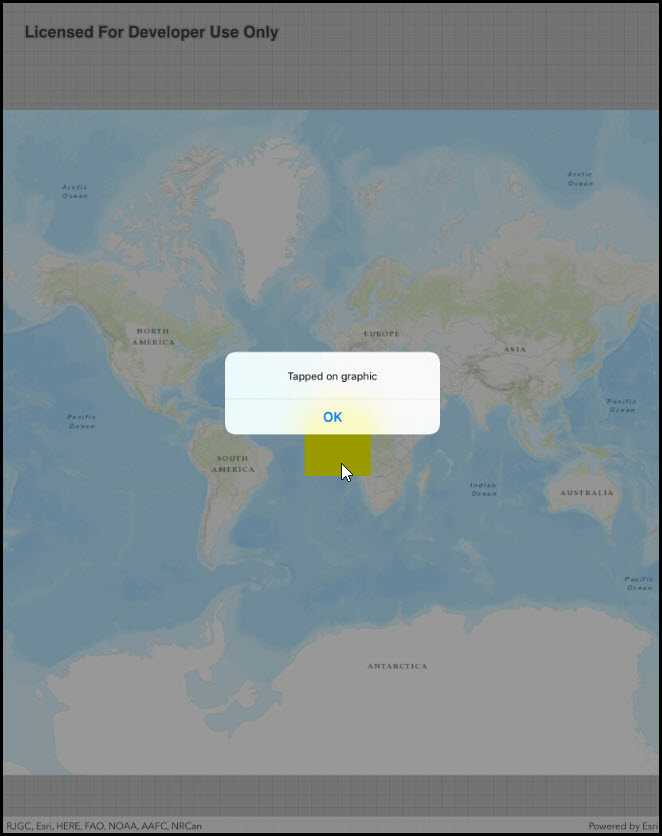Display an alert message when a graphic is clicked.

Use case
A user may wish to select a graphic on a map to view relevant information about it.
How to use the sample
Select a graphic to identify it. You will see an alert message displayed.
How it works
- Create a
GraphicsOverlayand add it to theMapView. - Add a
Graphicalong with aSimpleFillSymbolto the graphics overlay. - Create a
Pointfrom the location clicked on the map view by the user. - Identify the graphic on the map view with
IdentifyGraphicsOverlayAsync(graphicsOverlay, pointClicked, tolerance, max results).
Relevant API
- Graphic
- GraphicsOverlay
- MapView
Tags
graphics, identify
Sample Code
IdentifyGraphics.cs
// Copyright 2016 Esri.
//
// Licensed under the Apache License, Version 2.0 (the "License"); you may not use this file except in compliance with the License.
// You may obtain a copy of the License at: http://www.apache.org/licenses/LICENSE-2.0
//
// Unless required by applicable law or agreed to in writing, software distributed under the License is distributed on an
// "AS IS" BASIS, WITHOUT WARRANTIES OR CONDITIONS OF ANY KIND, either express or implied. See the License for the specific
// language governing permissions and limitations under the License.
using System;
using Esri.ArcGISRuntime.Data;
using Esri.ArcGISRuntime.Geometry;
using Esri.ArcGISRuntime.Mapping;
using Esri.ArcGISRuntime.Symbology;
using Esri.ArcGISRuntime.UI;
using Esri.ArcGISRuntime.UI.Controls;
using Foundation;
using UIKit;
namespace ArcGISRuntime.Samples.IdentifyGraphics
{
[Register("IdentifyGraphics")]
[ArcGISRuntime.Samples.Shared.Attributes.Sample(
name: "Identify graphics",
category: "GraphicsOverlay",
description: "Display an alert message when a graphic is clicked.",
instructions: "Select a graphic to identify it. You will see an alert message displayed.",
tags: new[] { "graphics", "identify" })]
public class IdentifyGraphics : UIViewController
{
// Hold references to UI controls.
private MapView _myMapView;
// Graphics overlay to host graphics.
private GraphicsOverlay _polygonOverlay;
public IdentifyGraphics()
{
Title = "Identify graphics";
}
private void Initialize()
{
// Create and show a topographic basemap.
_myMapView.Map = new Map(BasemapStyle.ArcGISTopographic);
// Create graphics overlay with graphics.
CreateOverlay();
}
private void CreateOverlay()
{
// Create polygon builder and add polygon corners into it.
PolygonBuilder builder = new PolygonBuilder(SpatialReferences.WebMercator);
builder.AddPoint(new MapPoint(-20e5, 20e5));
builder.AddPoint(new MapPoint(20e5, 20e5));
builder.AddPoint(new MapPoint(20e5, -20e5));
builder.AddPoint(new MapPoint(-20e5, -20e5));
// Get geometry from the builder.
Polygon polygonGeometry = builder.ToGeometry();
// Create symbol for the polygon.
SimpleFillSymbol polygonSymbol = new SimpleFillSymbol(
SimpleFillSymbolStyle.Solid,
System.Drawing.Color.Yellow,
null);
// Create new graphic.
Graphic polygonGraphic = new Graphic(polygonGeometry, polygonSymbol);
// Create overlay to where graphics are shown.
_polygonOverlay = new GraphicsOverlay();
_polygonOverlay.Graphics.Add(polygonGraphic);
// Add created overlay to the MapView.
_myMapView.GraphicsOverlays.Add(_polygonOverlay);
}
private async void OnMapViewTapped(object sender, GeoViewInputEventArgs e)
{
try
{
// Use the following method to identify graphics in a specific graphics overlay.
IdentifyGraphicsOverlayResult identifyResults = await _myMapView.IdentifyGraphicsOverlayAsync(
graphicsOverlay: _polygonOverlay,
screenPoint: e.Position,
tolerance: 10d,
returnPopupsOnly: false,
maximumResults: 1);
// Check if we got results.
if (identifyResults.Graphics.Count > 0)
{
// Make sure that the UI changes are done in the UI thread.
InvokeOnMainThread(() =>
{
UIAlertView alert = new UIAlertView("", "Tapped on graphic", (IUIAlertViewDelegate) null, "OK", null);
alert.Show();
});
}
}
catch (Exception ex)
{
new UIAlertView(title: "Error", message: ex.ToString(), del: (IUIAlertViewDelegate) null, cancelButtonTitle: "OK", otherButtons: null).Show();
}
}
public override void ViewDidLoad()
{
base.ViewDidLoad();
Initialize();
}
public override void LoadView()
{
// Create the views.
View = new UIView() { BackgroundColor = ApplicationTheme.BackgroundColor };
_myMapView = new MapView();
_myMapView.TranslatesAutoresizingMaskIntoConstraints = false;
// Add the views.
View.AddSubviews(_myMapView);
// Lay out the views.
NSLayoutConstraint.ActivateConstraints(new[]
{
_myMapView.TopAnchor.ConstraintEqualTo(View.SafeAreaLayoutGuide.TopAnchor),
_myMapView.BottomAnchor.ConstraintEqualTo(View.BottomAnchor),
_myMapView.LeadingAnchor.ConstraintEqualTo(View.LeadingAnchor),
_myMapView.TrailingAnchor.ConstraintEqualTo(View.TrailingAnchor)
});
}
public override void ViewWillAppear(bool animated)
{
base.ViewWillAppear(animated);
// Subscribe to events.
_myMapView.GeoViewTapped += OnMapViewTapped;
}
public override void ViewDidDisappear(bool animated)
{
base.ViewDidDisappear(animated);
// Unsubscribe from events, per best practice.
_myMapView.GeoViewTapped -= OnMapViewTapped;
}
}
}